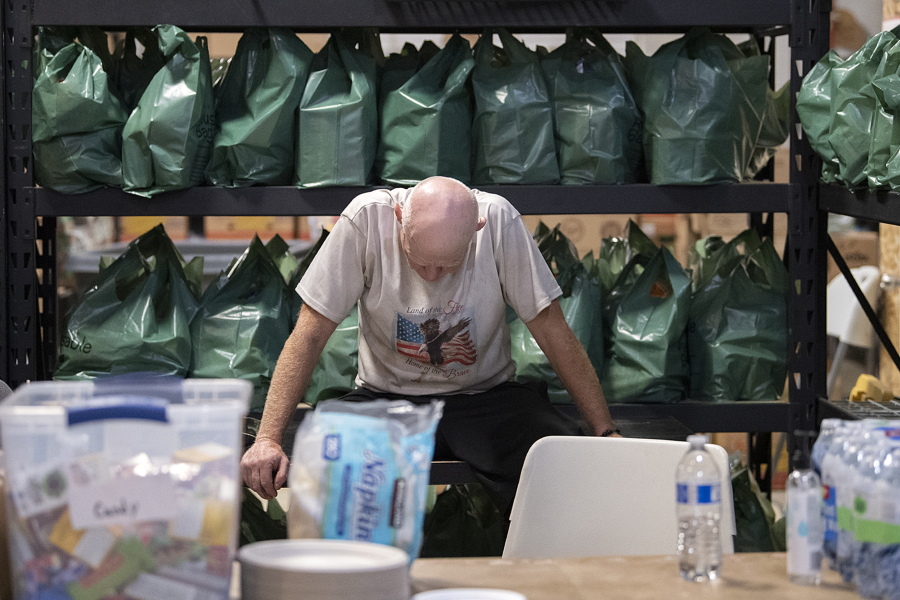J.P. Walmer spent the first day living outside chasing the shade to stay out of the 103-degree heat.
He wasn’t alone — several others at the encampment by Vancouver City Hall slept in open tents or in patches of shade on Monday.
Walmer said he doesn’t want to go to one of the county’s designated cooling shelters out of fear his possessions might be stolen, so he lays reading against a tree, periodically sipping from the water a Catholic church gave him.
“All it is, is clothing, but it’s my clothing,” he said.
Although cooling centers were open this week, Walmer’s experience highlights a problem: Many people who are most at risk for the extreme dangers of heat have the most barriers to staying cool.
A heat wave brought temperatures of up to 108 degrees in Vancouver on Monday and 102 on Tuesday. Those temperatures would have threatened or broken long-standing records were it not for the June 2021 heat dome event that killed 100 people in Washington.
During extreme weather events, Council for the Homeless sends out a call to local organizations to open cooling centers — places open to the public where people can stay cool indoors.
The list of places the Council sends out includes public parks, libraries, community centers and some churches.
Yet some cooling centers report that few, if any people, showed up. People living outside said they didn’t know where the cooling centers were, while others didn’t have transportation to get there or feared their belongings would be stolen if they left their camps.
‘What’s a cooling center?’
Tracy Miller, Spencer Dickinson and their children, both under the age of 2, drank from 24-ounce water bottles while trying to keep cool under the shade.
The family lives in their RV without air conditioning. They’ve been keeping their children hydrated with water supplied by the nearby Share House and cooling them off by splashing water on their necks.
When asked why they weren’t at one of the county’s designated cooling centers, Dickinson asked, “What’s a cooling center?”
They said they had no idea there were additional public places with air conditioning that opened up during extremely hot weather. No one had told them, they said.
“If we had addresses of places, then we’d know where we can go where (the children) can play and also stay safe at the same time,” Miller said.
The council’s list is shared via email and social media. People can also call the Council for the Homeless’ Housing Hotline to find out information.
Workers from the council handing out cooling resources will direct the people they come across to cooling centers, but the council does not provide paper lists with addresses of the cooling centers to people on the street, the council’s spokesperson, Charlene Welch, said in an emailed statement.
“Many people have phones and find cooling locations via social media, agency staff, and the Housing Hotline,” Welch said.
Spreading the word about heat events often relies on technology because it’s fast, said Vivek Shandas, a professor of climate adaptation at Portland State University who studies how extreme heat impacts different communities.
When people don’t have access to technology, it makes finding resources more difficult. A 2017 study published in the Journal of Social Distress and Homelessness found that one-third of its homeless participants had not accessed the internet in the last three months of the study.
“If they don’t have a place to go to look for potential locations, it can immediately curtail or even completely halt the ability to get word out to a lot of folks who don’t have a direct computer to use or have a phone that has access to locations,” Shandas said.
Alicia Smith, who works at St. Paul Lutheran Church, one of the cooling centers open this week, said most people know about the center through word of mouth.
As a result, some cooling centers don’t get accessed. River City Church only saw a handful of people and a cat, said River City Church Pastor Noah Sidhom. He thinks many people don’t know they’re an option. But said all are welcome.
Mill Plain United Methodist Church hadn’t had anyone access its cooling space as of Tuesday afternoon. Both churches said people can come in for food, bring pets and their belongings with them.
Living Hope Church provided relief to 25 people on Monday, which may be due to their outreach. Volunteers also offered to pick people up who were walking along Andersen Road.
A heat nightmare
Multnomah County has been trying to improve its response to helping vulnerable people during extreme heat. The county has two overnight shelters, over a dozen 24-hour misting stations at parks and free public transportation to cooling centers. Clark County has none of these.
Council for the Homeless’ outreach teams have the ability to give free bus tickets or vouchers for motels, but they don’t have vans to transport people, and motel vouchers are reserved for people who are unable to go to cooling centers and are the most vulnerable to nighttime heat. The use of those vouchers is prioritized when cooling centers cannot open, Welch said.
Shandas said heat at night is especially dangerous because the body stops regulating its temperature.
“That really gets into some pretty severe impacts, because we see most people that died from heat waves usually die at night when they’re sleeping,” he said.
Ronald, 58, spent the day at Living Hope Church’s cooling center, but when he returns home, he fears death.
“It’s like the blaze of hell,” he said. “I’m old and living in a place with no air … my (concern) is that I’ll die,” he said.
During last year’s heat spell, Korrenna Raby, Mike VanLoan and dog, Pistol, who live in their car, went to a 24/7 cooling center in Portland to keep cool during the hot weather. But this year, they don’t know how they will stay cool tonight after leaving the church.
They can’t run their air conditioner for too long, because it drains their gas.
“We don’t have enough gas, we barely borrowed enough money from family just to make it here,” said Raby, who added the couple only knew about the church’s cooling center because they called 211.
“It was really miserable in the car last night,” said Raby. “We didn’t get any sleep.”
Besides long-term planning for heat events and improved communication, Shandas said cities need to focus on bringing resources to communities in need as opposed to having communities find those resources.
Alerting affordable housing without AC or mobile home parks of where the cooling centers are is an example, he said.
“These extreme events generally are really going to lay bare the level of precarity that those who have the least access to resources are going to face,” Shandas said. “And if we’re not taking care of those folks who have the least access to resources, then it really reflects on our broader societal ability to cope with these extreme events.”





